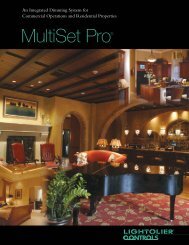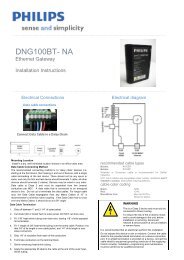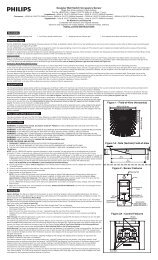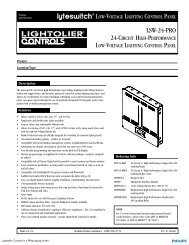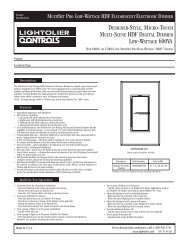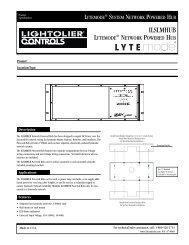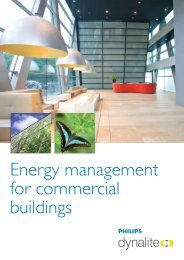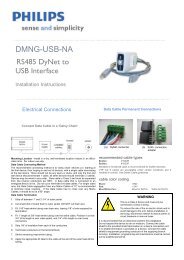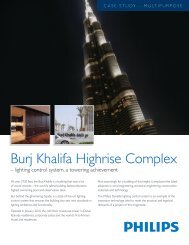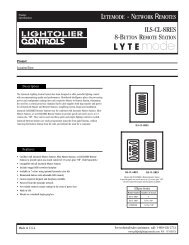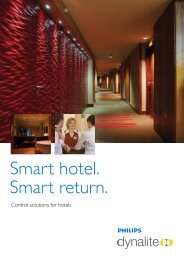Lightnews Vol 10.pdf - Philips Lighting Controls
Lightnews Vol 10.pdf - Philips Lighting Controls
Lightnews Vol 10.pdf - Philips Lighting Controls
You also want an ePaper? Increase the reach of your titles
YUMPU automatically turns print PDFs into web optimized ePapers that Google loves.
“<br />
The design is challenging<br />
the expectation that hotel<br />
lights need to be on all the<br />
time. . . [It] delivers both<br />
the environmental and<br />
architectural outcome we<br />
were seeking.<br />
”<br />
Stunning architectural<br />
and mood lighting belie<br />
the considerable energy<br />
savings realised—with an<br />
internal lighting efficacy of<br />
just 3.36 watts per square<br />
metre being achieved.<br />
Obvious choice<br />
“The design brief called for an integrated<br />
lighting control system to provide pre-set<br />
lighting scenes in all public areas and mood<br />
lighting to bedrooms—all controlled by<br />
a combination of wall-controls, remote<br />
controls and motion sensors,” said<br />
Lightmaster Design Director, Richard Nock.<br />
“A <strong>Philips</strong> Dynalite solution was the obvious<br />
choice. Its controllers are without question<br />
the best on the market for fluorescent<br />
and LED lighting, and the <strong>Philips</strong> Dynalite<br />
solution-set remains our preferred lighting<br />
control system to work with, due to its<br />
performance, reliability and versatility.”<br />
The Scarlet’s fluorescent and LED circuits<br />
are controlled by a combination of <strong>Philips</strong><br />
Dynalite relay and ballast controllers. <strong>Philips</strong><br />
Dynalite universal sensors help ensure<br />
that lighting only activates when areas are<br />
occupied and when ambient light levels fall<br />
below a threshold level. The backbone to<br />
the lighting control system is provided by<br />
<strong>Philips</strong> Dynalite’s sophisticated peer-to-peer<br />
communications serial bus network, DyNet.<br />
Two <strong>Philips</strong> Dynalite touch-screen control<br />
panels allow the lighting moods of the public<br />
areas to be set by the hotel staff. Revolution<br />
2 user-interface wall panels permit local<br />
user control for some public areas and<br />
all the guest rooms. Each guest room has<br />
two engraved and backlit Revolution 2<br />
wall panels that allow guests to match<br />
their mood from a choice of seven lighting<br />
scenes—‘ambient’, ‘bright’, ‘relax’, ‘bath’,<br />
‘night’, ‘balcony’, and ‘all off’.<br />
Staggering savings<br />
In spite of the architectural and mood<br />
lighting results achieved, considerable<br />
energy savings have been realised. “Where<br />
a conventional hotel typically achieves<br />
lighting efficacy of 10 watts per square<br />
metre, the design brief for the Scarlet called<br />
for 8 watts per square metre,” said Nock.<br />
“However, the finished system achieved a<br />
staggering internal lighting efficacy of just<br />
3.36 watts per square metre—representing<br />
just 34 per cent of the energy use of a<br />
conventional design.<br />
“We have also achieved significant energy<br />
savings with the garden lighting. Using<br />
discreet 1 watt LED fittings, a subtle and<br />
beautiful garden lighting design has been<br />
achieved using less than 100 watts in total!”<br />
In order to measure actual power<br />
consumption—and to facilitate real-time<br />
monitoring for maintenance—of the lighting<br />
system, the Scarlet is considering the<br />
addition of a DLight III server and MapView<br />
software from <strong>Philips</strong> Dynalite to the lighting<br />
infrastructure. This will enable fine tuning<br />
of the system over time to achieve further<br />
energy savings in the future.<br />
“The goal of this project was to build a<br />
unique and opulent hotel in a beautiful<br />
location, and to achieve performance at the<br />
cutting edge of environmental sustainability,”<br />
said Baldwin. “The Scarlet proves that you<br />
don’t have to sacrifice luxury to achieve high<br />
levels of energy efficiency. Scarlet really is<br />
the new green!”<br />
<strong>Lightnews</strong> <strong>Vol</strong> 10 | 5



